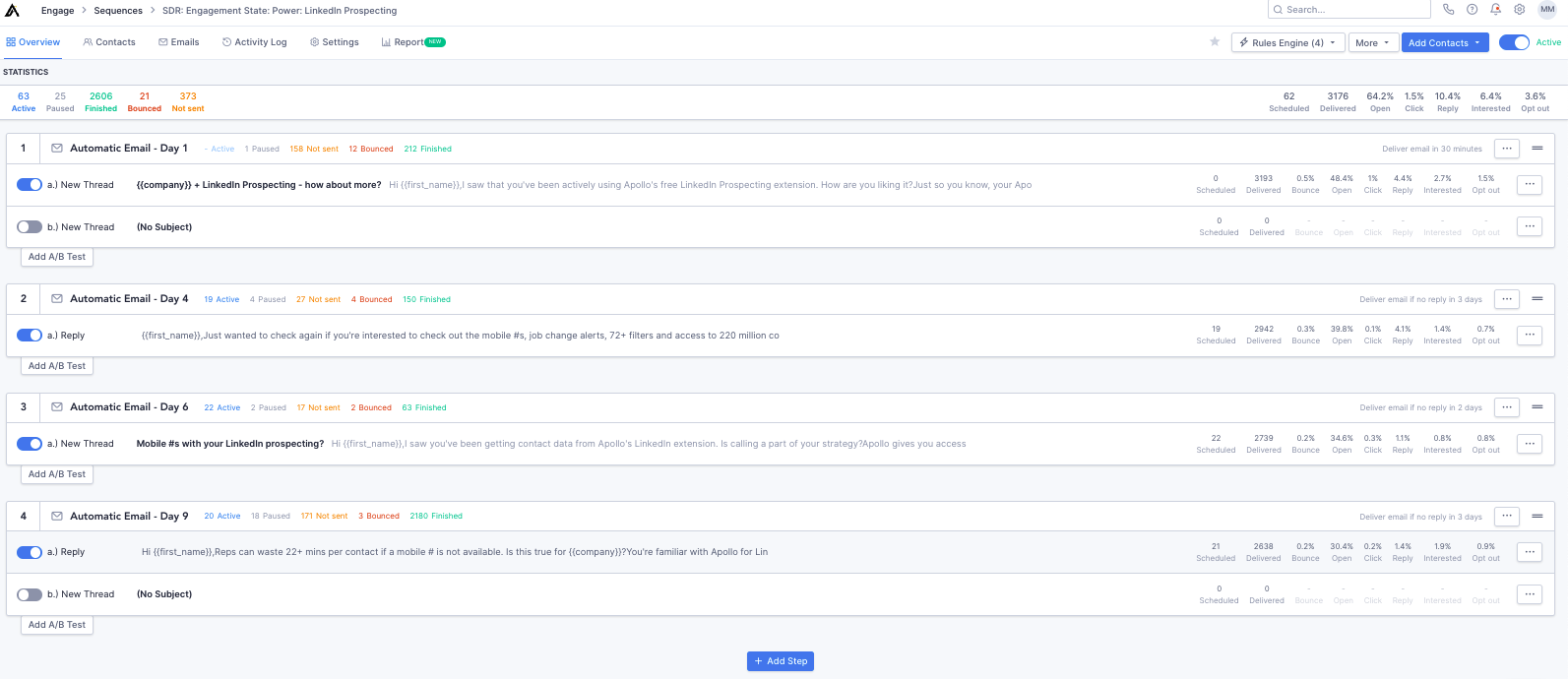If you have an Apollo.io account, building out effective sales sequences is one of the most important things you can do to connect with contacts, drive more conversions, and outpace your goals.
In recent customer interviews, 75% of Apollo’s top power users said that sequences and sequencing automation is a must-use feature across your sales cadence.
Sequences are an infinitely productive sales tool – but sometimes that can make it tricky to know where to begin…
In this blog, you’ll learn more about sales sequences, receive real examples of top-performing sequences here at Apollo, and learn the sequencing tips and tricks to instantly improve your sales campaigns.
Let’s dive in.
What are Sequences?
Sequences are your own personalized and automated outreach campaigns to your new prospects.
You equip them with any number of sequential contact points and tasks and customize them to personally engage your target audiences at scale.
When you build out your sequences, you have 8 steps to choose from and arrange:
- Automatic Email: Use any of your Apollo email templates or create new ones to craft personalized and targeted messaging that is delivered based on the parameters you set.
- Manual Email: Use to schedule and deliver follow-up emails that you can fully customize for individual prospects.
- Phone Call: Add notes, tips, scripts, and any other helpful information with a reminder to call a prospect.
- Action Item: A blank canvas to schedule any number of necessary internal communications or processes along the way.
- LinkedIn: View Profile: Access a contact’s LinkedIn profile from within Apollo and document key information that can help you build rapport when engaging with prospects.
- LinkedIn: Interact With Post: Review a contact’s activities, engage with their recent posts, and give yourself direction with reminders and relevant notes.
- LinkedIn: Send a Connection Request: Create connection request templates to make a great first impression.
- LinkedIn: Send Message: Send personalized InMail messages
The timing between these steps is all determined by you. Schedule a specific time and date for steps to automatically happen or tell Apollo how long to wait between each sequencing step.
The optimal timing for your target audience will depend on the type of sales strategy you choose. Research your industry, plan your strategy, and then A/B test to find the approach that works best for your ideal customers.
The benefits of using Sales Sequences
“I sat down with my boss and we said ‘Look at this sequencing! I’ve never seen this before, it’s so much better than just pulling names…’ We discovered it together, the efficiency of this tool.” – Jordan Heil, Account Executive at Synapse and Apollo User
Apollo’s Sequences are like nothing on the market.
They help your team deliver communications to your future customers and complete the right tasks at the right time to speed your prospects through your pipeline and turn them into paying customers as efficiently as possible.
Specific benefits Apollo Sequences gives you include:
- Institutionalized best practices for engaging leads into easy-to-follow guides that automatically add defined tasks to your Apollo dashboards on set schedules, which ensures consistency and accountability for your sales team.
- A/B testing for message templates, scripts, and strategies to confirm the best version of any step in your sales process.
- Reporting to compare and optimize your approach and help you to confirm the best times for every message you send.
- Detailed analytics that are specific to your messaging and sales activities, such as how many messages were delivered, opened, replied to, and bounced.
Whew, that was a lot of info!
Let’s take this knowledge to the next level – here are some highly successful Sequences our own team uses at Apollo and why they work:
Top-performing Sequences used by the Apollo team
#1: Sequence for users using free features

As you can see from the data, this automated email sequence has been sent to well over 3k recipients and has near a 64% open rate and over a 10% reply rate!
It’s a simple sequence that produces big results.
This sequence targets Apollo users that have been actively using our free Chrome Extension for LinkedIn Prospecting. The call-to-action (aka the “ask” of the sales email sequence) is for the buyer to meet with an Apollo Account Executive for a more detailed overview of our product and the many powerful features they are not yet utilizing.
It works because we ensure it stays highly targeted, relevant, and personalized.
It’s not for prospects who request a demo, who have already signed up for a paid plan, or for prospects who are completely cold. It’s for prospects who are having success using our LinkedIn prospecting tool. These are the specific prospects who will resonate with the sequences’ messaging.
Use this sequence to speak to specific segments of customers and meet them where they are at in their stage of the buying cycle.
#2: Sequence for job changes

This is another high-performing outreach sequence for Apollo.
With three automatic emails and a LinkedIn request over six days, this sequence is aimed at prospects who are previous users of our product and have recently changed companies. It asks if they want to meet with an Apollo sales rep to discuss how they can integrate Apollo into their new role.
This is an example of a sales sequence that’s all about leveraging perfect buying opportunities. When people change companies, they need to establish a new workflow and are very receptive to using new tools to help them get work done.
They are at a perfect place to buy a B2B product and this sequence is a beautiful example of email outreach that delivers the right message to the right people at just the right time.
If you’re a part of a B2B sales team, you can use this sequencing format (along with our handy Job Change Alerts) to automatically reach out at pivotal sales moments.
#3: Sequence for re-establishing product value

Spanning over 11 days, this sequence is a bit more detailed.
It’s targeted at the decision-maker (in this case, the original creator of the company’s account). It lets them know that their teammates are still actively using the product and getting value out of it. It asks if they have time to meet with the AE to re-establish value and go over their needs.
This sequence has over a 77% open rate! Why?
Because it takes a multi-channel approach (email and LinkedIn), includes grabby email subject lines, and uses strategic timing and sending schedules. Not to mention it is highly targeted and personalized.
The best part is: all of these sequencing functions are available to you too!
Other sequencing tips & tricks
Before you go, we have a few more tips to help you create the perfect sales sequence:
- Develop a multi-channel approach. Mixing different emails, phone, and social media touchpoints can help you stand out from the crowd.
- Involve your best sellers in your sequence content creation. Sellers are the ones interacting and engaging with prospective buyers the most. Leverage their knowledge of your target audience and implement their valuable insights.
- Mine your sales discovery calls for great sequence content ideas. Make an effort to listen for prospects actively talking about pain points, roadblocks, and goals. Mirroring their exact language in your sequences will get you better conversion rates.
- Don’t be afraid to embed visuals. You can include screenshots of your product, funny memes, a case study, comparisons or graphs illustrating your point, etc.
- Always test before a scaled-up launch. Test out your sequence for a minimum of 300 contacts for statistically significant results.
- Practice continuous optimization. Even after testing, when a sequence is launched, develop methods to actively monitor whether conversion rates (replied, open, interested rates) are holding as expected – Is there seasonality or a timing element in the sequence you should adapt to?
- Set differentiated goals. After conducting initial tests, your conversion goals for your sequences should be based on whether your target contacts are warm (aware of your product and company) or cold (need to be educated about your product or company). These sequences have vastly different approaches and your goals should reflect that.
- Save time and recycle content. It’s helpful to keep a library of “blurbs” for common themes you tend to touch on and the phrases, stats, and value points that resonate best. You can reuse this in different templates easily and scale outreach.
With the insights from this guide, you have everything you need to create an automated outreach campaign that moves deals forward.
Well, almost everything…
You need to sign up for your own Apollo.io account! It’s simple to set up, free to try, and gives you everything you need to make selling clear, quick, and effective.
Happy Sequencing!





